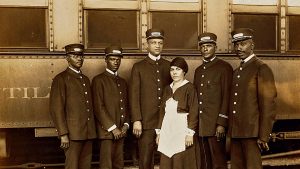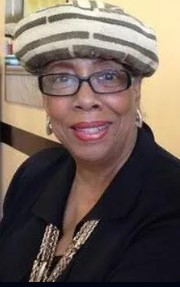Museum campus helps get Pullman area back on track
By Kevin Beese Staff Writer — April 16, 2025
A Pullman maid is surrounded by Pullman porters. A museum looking at the women who supported the Pullman porters and other noteworthy women is planned near the National A. Philip Randolph Pullman Museum on Chicago’s South Side. (Photo courtesy of The Dr. Robert L. Drapkin Collection at the Smithsonian American Art Museum)
A woman looking for a fresh start has given a previously neglected area of Chicago a do-over as well.
Thirty-plus years ago, Lyn Hughes was a recently divorced mom of three, wanting to relocate to a place where she didn’t know anybody.
“I was trying to figure out what I was going to do,” Hughes said. “I hadn’t done anything but have a singing career and be married.
“I had some money, so I said, ‘Let me figure out how to spend it.’”
After Hughes decided on Chicago, an acquaintance directed her to north end of the Pullman neighborhood on the city’s South Side. Hughes bought three buildings, each for less than $10,000.
When her brother, who was in construction, saw the buildings, he gave his sister some advice.
“‘Get the bulldozer and leave it alone,’” Hughes remembered him saying. “He said, ‘You don’t really want to do this, do you?”
However, Hughes felt a connection to the area, partially because, architecturally, it looked much like her hometown of Cincinnati.
After twice talking to the same set of boys on a Pullman street corner, Hughes felt she needed to commit to the neighborhood.
‘Do something’
“Something about them made me feel like I needed to go back and do something,” she said.
However, what that something was remained elusive.
She happened to attend a local library program about the Pullman train porters and their impact on the neighborhood.
“The speaker talked about the wonderful place that was built (Pullman),” Hughes said. “Why didn’t the residents feel like that?”
Days later, in the middle of the night, the epiphany came.

Lyn Hughes
“I woke up and sat up in bed at 4 a.m. and said, ‘I’m going to create a museum. I don’t know anything about museums, but I’m doing this,’” Hughes remembered. “I told my mother, and she asked, ‘Have you lost your mind?’”
Hughes stuck with it and created the National A. Philip Randolph Porter Museum, which is celebrating its 30th anniversary this year. The museum draws more than 150,000 guests to the Pullman neighborhood each year.
Hughes now has her sights set on creating the Brotherhood of Sleeping Car Porters Ladies Auxiliary Women’s History Museum. A groundbreaking for the museum, just doors south of the Porter Museum, was held at the end of March.
It is the first extension of the planned museum campus and the first Black labor history tourism district in America.
The establishment of the BSCP Ladies Auxiliary Women’s History Museum aims to elevate the little-known stories and contributions of Black women throughout history, according to Hughes. It is a commitment to preserving the narratives of those who did the work, paved the way, and too often were overlooked, Hughes said, adding that their struggles and successes will serve as a source of inspiration for future generations.
Museum honorees
Some of the women to be featured in the museum include:
· Shirley Chisholm, the first Black woman to be elected to the U. S. Congress and the first Black woman to seek the nomination of president of the United States
· Carol Moseley Braun, the first Black woman elected to the U.S. Senate
· Kim Foxx, the first Black woman elected to serve as Cook County state’s attorney.
· Lyn Hughes, founder of the National A. Philip Randolph Pullman Porter Museum, the first Black labor history museum in the nation
· Rosina Tucker, labor organizer and the first president of the BSCP union’s Ladies Auxiliary
· Madame C.J. Walker, the first self-made millionaire, who was also an entrepreneur and philanthropist
The Brotherhood of Sleeping Car Porters, established in 1925, marked a monumental moment in American labor history as the first Black labor union to receive a charter from the American Federation of Labor, museum personnel said. The organization played a vital role in advocating for fair wages, improved working conditions, and gained respect for Black workers in the face of systemic racism and discrimination, according to Hughes.
The women of the Ladies Auxiliary contributed significantly to the achievements, often working behind the scenes to support and empower their families while also striving for their own rights and recognition, Hughes said. She noted that many of the individuals who were part of the BSCP, and the Ladies Auxiliary went on to become the foundation of the emerging Black middle class. In addition, the BSCP became the backbone of the boots on the ground to drive the Civil Rights Movement, Hughes added.
The new museum will act as a vital repository of the stories of Black women, shedding light on the crucial role the BSCP Ladies Auxiliary played within the broader labor movement, while highlighting others who helped pave the way, according to Hughes. By documenting their experiences, she said, the museum aims to provide a comprehensive understanding of the intersection of race, gender, and class in American labor history.







